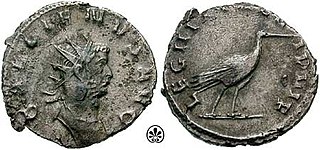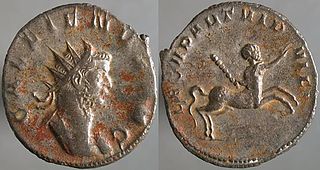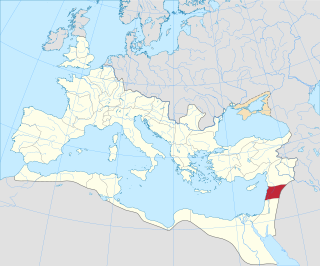Related Research Articles

Marcus Aurelius Severus Alexander, also known as Alexander Severus, was Roman emperor from 222 until 235. The last emperor from the Severan dynasty, he succeeded his slain cousin Elagabalus in 222, at the age of 13. Alexander himself was eventually assassinated, and his death marked the beginning of the events of the Crisis of the Third Century, which included nearly fifty years of civil war, foreign invasion, and the collapse of the monetary economy.

The Tetrarchy was the system instituted by Roman emperor Diocletian in 293 AD to govern the ancient Roman Empire by dividing it between two emperors, the augusti, and their junior colleagues and designated successors, the caesares.
The 230s decade ran from January 1, 230, to December 31, 239.

Gordian III was Roman emperor from 238 to 244. At the age of 13, he became the youngest sole emperor of the united Roman Empire. Gordian was the son of Antonia Gordiana and Junius Balbus, who died before 238. Antonia Gordiana was the daughter of Emperor Gordian I and sister of Emperor Gordian II. Very little is known of his early life before his acclamation.

Gordian I was Roman emperor for 22 days with his son Gordian II in 238, the Year of the Six Emperors. Caught up in a rebellion against the Emperor Maximinus Thrax, he was defeated in battle and committed suicide after the death of his son, having had the shortest reign in imperial history.

Gordian II was Roman emperor with his father Gordian I in 238 AD, the Year of the Six Emperors. Seeking to overthrow Maximinus Thrax, he died in battle outside Carthage. Since he died before his father, Gordian II had the shortest reign of any Roman emperor, at about 22 days.

Legio VIII Augusta was one of the oldest legions of the Imperial Roman army.

Legio III Italica was a legion of the Imperial Roman army founded in 165 AD by the emperor Marcus Aurelius for his campaign against the Marcomanni tribe. The cognomen Italica suggests that the legion's original recruits were drawn for the defence of Italy. The legion was still active in Raetia and other provinces in the early 5th century.

Legio II Parthica was a legion of the Imperial Roman army founded in AD 197 by the emperor Septimius Severus, for his campaign against the Parthian Empire, hence the cognomenParthica. The legion was still active in the beginning of the 5th century. The legion's symbol was a centaur.

Marcus Clodius Pupienus Maximus was Roman emperor with Balbinus for 99 days in 238, during the Year of the Six Emperors. The sources for this period are scant, and thus knowledge of the emperor is limited. In most contemporary texts he is referred to by his cognomen "Maximus" rather than by his second nomen Pupienus.
The limitanei, meaning respectively "the soldiers in frontier districts" or "the soldiers on the riverbank", were an important part of the late Roman and early Byzantine army after the reorganizations of the late 3rd and early 4th centuries. The limitanei, unlike the Comitatenses, palatīni, and Scholae, garrisoned fortifications along the borders of the Roman Empire and were not normally expected to fight far from their fortifications.

Legio V Macedonica was a Roman legion. It was probably originally levied in 43 BC by consul Gaius Vibius Pansa Caetronianus and Gaius Julius Caesar Octavianus. It was based in the Balkan provinces of Macedonia, Moesia and Dacia. In the Notitia Dignitatum records from beginning of the fifth century, the legion was still stationed in Dacia, with detachments stationed in the east and Egypt.

Legio V Iovia was a Roman legion levied by Diocletian in the end of the 3rd century, and was still in service at the beginning of the 5th century. The cognomen of the legion refers to Jupiter, to whom Diocletian was devoted and identified.

The Year of the Six Emperors was the year AD 238, during which six men made claims to be emperors of Rome. This was an early symptom of what historians now call the Crisis of the Third Century, also known as Military Anarchy or the Imperial Crisis, a period in which the Roman Empire nearly collapsed under the combined pressures of foreign invasions and migrations into the Roman territory, plagues, civil wars, peasant rebellions, political instability, Roman reliance on foreign mercenaries known as foederati and commanders nominally working for Rome, the devastating social and economic effects of the plague, debasement of currency, and economic depression. The crisis ended with the final victory of Diocletian and his implementation of reforms in 285.
The palatini were elite units of the Late Roman army mostly attached to the comitatus praesentales, or imperial escort armies. In the elaborate hierarchy of troop-grades, the palatini ranked below the scholares, but above the comitatenses and the limitanei.

Gaius Julius Verus Maximinus "Thrax" was a Roman emperor from 235 to 238. Born of Thracian origin – given the nickname Thrax – he rose up through the military ranks, ultimately holding high command in the army of the Rhine under Emperor Severus Alexander. After Severus was murdered in 235, he was proclaimed emperor by the army, beginning the Crisis of the Third Century, a 50-year period of instability and civil war. He is often remembered for his unusual height, although the veracity of this is disputed.

The siege of Aquileia was a siege battle that took place in 238 in the town of Aquileia during the Year of the Six Emperors, which resulted in the assassination of Maximinus Thrax.

Phoenice was a province of the Roman Empire, encompassing the historical region of Phoenicia. It was officially created in 194 AD and after c. 394, Phoenice Syria was divided into Phoenice proper or Phoenice Paralia, and Phoenice Libanensis, a division that persisted until the region was conquered by the Muslim Arabs in the 630s.

The Sassanid campaign of Alexander Severus was an episode of the Roman–Sasanian Wars (224-363) that saw the Roman Empire ruled by Emperor Alexander Severus (222-235) confront the dominance of the Sasanids, led by Ardashir I (224-241): the war was fought between 230 and 232, originating from an attempted Sasanian expansion into the eastern Roman provinces, and resolved with a return to the status quo ante.

The Mesopotamian campaigns of Ardashir I represented the first episode in a new period of wars between the Romans and Sasanids. The war between the Roman Empire, ruled by the Roman emperor Severus Alexander (222-235), and the Sasanian rule, led by Ardashir I (224-241), lasted for more than a decade, from 229 to 241 when the Sasanian ruler died and was replaced by his son, Shapur I.
References
- ↑ Herodian, VI, 3.1; Parker, 176.
- ↑ Herodian, VI, 8.2–3; Historia Augusta, "The Two Maximini", 5.5; Gonzales, vol.I, p. 165.
- ↑ Gonzales, p.166
- ↑ Historia Augusta, "The Three Gordians", 25.2; Ritterling, c.1326; Gonzales, p.166.
- ↑ Luttwak, p. 231–232; Gonzales, p. 166.
- ↑ J.Kromayer e G.Veith, p.483, map 54, illustration 147; Nischer, p. 22.
- ↑ Diehl, p. 146; Runciman, p. 125; Gonzales, p. 166.
